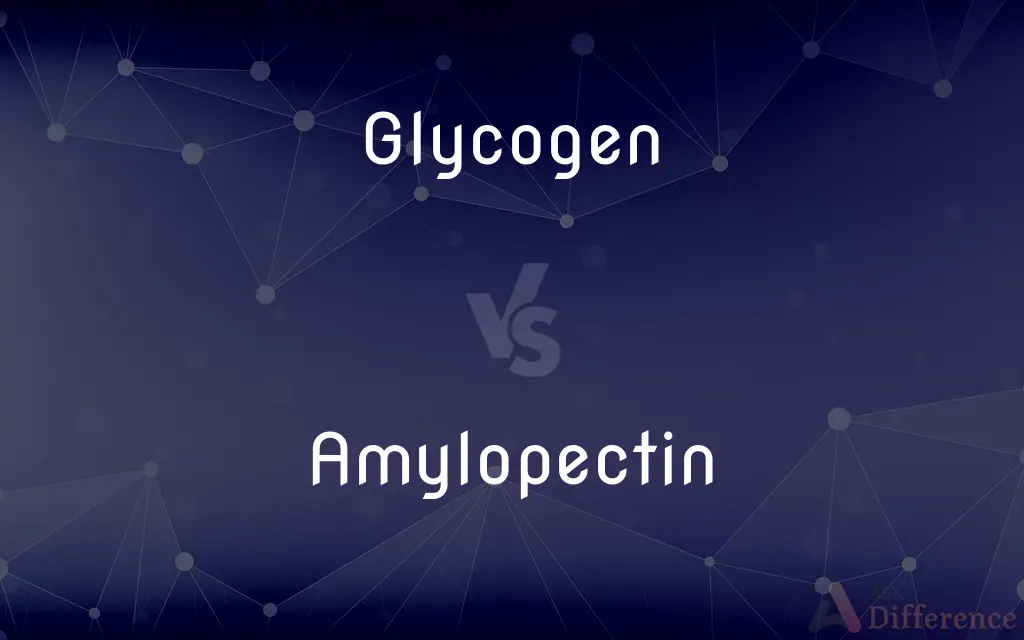Glycogen vs. Amylopectin — What's the Difference?
Edited by Tayyaba Rehman — By Maham Liaqat — Updated on April 17, 2024
Glycogen serves as a primary energy storage in animals, highly branched for rapid energy release; amylopectin, a plant starch component, has fewer branches, affecting its digestibility.

Difference Between Glycogen and Amylopectin
Table of Contents
ADVERTISEMENT
Key Differences
Glycogen is a complex carbohydrate stored predominantly in the liver and muscles of animals, designed for quick energy release. On the other hand, amylopectin is one of two components of starch and serves as an energy reserve in plants.
The structure of glycogen is highly branched, with branches occurring every 8 to 12 glucose units. This high branching enhances the solubility and allows for rapid glucose release. Whereas amylopectin also has a branched structure, its branches are less frequent, occurring every 24 to 30 glucose units, which influences its digestibility and the speed of glucose release.
Glycogen's extensive branching is critical for animals that need immediate energy during sudden, intense activities. Amylopectin, with its relatively slower digestibility, aligns with the more constant energy demands of plants.
During digestion, enzymes break down glycogen rapidly due to its structure, which effectively increases the surface area available for enzyme action. In contrast, amylopectin's fewer branches mean it is digested more slowly, impacting how quickly glucose is available to the body.
In dietary terms, glycogen is not a significant component of human food because it is broken down in the meat post-slaughter. Amylopectin, however, as a major part of plant starch, plays a crucial role in human diets, particularly in foods like potatoes and rice.
ADVERTISEMENT
Comparison Chart
Primary Function
Quick energy release in animals
Energy reserve in plants
Branching Frequency
Every 8-12 glucose units
Every 24-30 glucose units
Solubility
Highly soluble
Less soluble
Role in Human Diet
Insignificant directly
Significant (e.g., rice, potatoes)
Enzymatic Digestibility
Rapidly digested
Digested more slowly
Compare with Definitions
Glycogen
A polysaccharide that functions as one of the primary forms of energy storage in animals.
Glycogen stores in the liver regulate the body's glucose levels.
Amylopectin
A component of starch, serving as energy storage in plants.
Amylopectin is a major part of the starch in foods like rice.
Glycogen
Highly branched molecular structure.
Glycogen's branched structure enables rapid release of glucose.
Amylopectin
Contributes to the gelatinization of starch during cooking.
Amylopectin causes rice to become sticky when cooked.
Glycogen
Predominantly found in the liver and muscle tissue.
Post exercise, muscle glycogen levels are significantly depleted.
Amylopectin
Major food source in human diets.
Amylopectin levels are high in potatoes and other starchy vegetables.
Glycogen
Not a direct dietary source for humans.
Glycogen breaks down in meats soon after the animal is slaughtered.
Amylopectin
Less branched than glycogen.
Amylopectin's structure causes it to digest more slowly than glycogen.
Glycogen
Essential for quick energy bursts.
Sprinters rely heavily on glycogen for short bursts of energy.
Amylopectin
Slower digestibility affects its role in nutrition.
Amylopectin's slower release of glucose is beneficial in managing energy levels.
Glycogen
Glycogen is a multibranched polysaccharide of glucose that serves as a form of energy storage in animals, fungi, and bacteria. The polysaccharide structure represents the main storage form of glucose in the body.
Amylopectin
Amylopectin is a water-soluble polysaccharide and highly branched polymer of α-glucose units found in plants. It is one of the two components of starch, the other being amylose.
Glycogen
A polysaccharide, (C6H10O5)n, that is the main form of carbohydrate storage in animals and is found primarily in the liver and muscle tissue. It is readily converted to glucose as needed by the body to satisfy its energy needs. Also called animal starch.
Amylopectin
A highly branched polysaccharide of high molecular weight that is one of the two main components, along with amylose, of starches.
Glycogen
(carbohydrate) A polysaccharide that is the main form of carbohydrate storage in animals; converted to glucose as needed.
Amylopectin
(carbohydrate) A highly branched, insoluble form of starch (the soluble form being amylose)
Glycogen
A white, amorphous, tasteless substance resembling starch, soluble in water to an opalescent fluid. It is found abundantly in the liver of most animals, and in small quantity in other organs and tissues, particularly in the embryo. It is quickly changed into sugar when boiled with dilute sulphuric or hydrochloric acid, and also by the action of amylolytic ferments.
Glycogen
One form in which body fuel is stored; stored primarily in the liver and broken down into glucose when needed by the body
Common Curiosities
Why is amylopectin important in the human diet?
It is a significant part of the starch in staple foods like rice and potatoes, influencing energy release and digestion.
How does the branching structure of glycogen benefit animals?
Glycogen's dense branching allows for rapid glucose mobilization, crucial during sudden, intense physical activities.
Is glycogen present in any foods?
While glycogen is present in meats, it is typically broken down into simpler sugars post-slaughter, hence not significant in human diets.
What is glycogen?
Glycogen is an animal polysaccharide used for storing energy, highly branched for rapid energy release.
Where is glycogen stored?
In animals, glycogen is stored mainly in the liver and muscle tissues.
How do the structures of glycogen and amylopectin differ?
Glycogen is more highly branched than amylopectin, which affects their roles and digestibility.
What impact does the structure of amylopectin have on food texture?
Amylopectin contributes to the viscosity and gel-like texture in cooked foods, notably in sticky rice and pudding.
What role does glycogen play in the human body?
In humans, glycogen serves as a critical energy reserve, especially for brain function and during physical exertion.
How does the digestibility of amylopectin compare to other dietary starches?
Amylopectin, with its less frequent branching, is digested more slowly than more highly branched starches like amylose.
What is amylopectin?
Amylopectin is a component of plant starch that serves as an energy reserve.
Can humans digest amylopectin and glycogen equally?
Humans can digest both, but enzymes break down glycogen more quickly than amylopectin due to its highly branched structure.
What enzymes are involved in breaking down glycogen and amylopectin?
Glycogen is primarily broken down by the enzyme glycogen phosphorylase, while enzymes like amylase play a significant role in amylopectin breakdown.
Which foods are high in amylopectin?
Foods like potatoes, rice, and certain types of bread are high in amylopectin, contributing to their characteristic textures.
Why is glycogen not a stable source of dietary glucose?
Glycogen quickly breaks down after an animal's death, making it unstable and impractical as a dietary glucose source.
Share Your Discovery

Previous Comparison
Inclusion vs. Integration
Next Comparison
Marxism vs. LeninismAuthor Spotlight
Written by
Maham LiaqatEdited by
Tayyaba RehmanTayyaba Rehman is a distinguished writer, currently serving as a primary contributor to askdifference.com. As a researcher in semantics and etymology, Tayyaba's passion for the complexity of languages and their distinctions has found a perfect home on the platform. Tayyaba delves into the intricacies of language, distinguishing between commonly confused words and phrases, thereby providing clarity for readers worldwide.














































